Red-tailed Black Cockatoo
| Red-tailed Black Cockatoo | |
|---|---|
-8-2cp.jpg) |
|
| A pair (male on left and female on right) | |
| Conservation status | |
| Scientific classification | |
| Kingdom: | Animalia |
| Phylum: | Chordata |
| Class: | Aves |
| Order: | Psittaciformes |
| Family: | Cacatuidae |
| Subfamily: | Calyptorhynchinae |
| Genus: | Calyptorhynchus |
| Subgenus: | Calyptorhynchus |
| Species: | C. banksii |
| Binomial name | |
| Calyptorhynchus banksii (Latham, 1790) |
|
| Subspecies | |
|
|
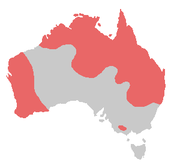 |
|
| Red-tailed Black Cockatoo range (in red) | |
The Red-tailed Black Cockatoo (Calyptorhynchus banksii), also known as Banksian- or Bank's Black Cockatoo, is a large cockatoo native to Australia. This species was known as Calyptorhynchus magnificus for many decades until the current scientific name was officially conserved in 1994. It is more common in the drier parts of the continent. Five subspecies are recognised, differing most significantly in beak size. Although the more northerly subspecies are widespread, the two southern subspecies, the Forest Red-tailed Black Cockatoo and the South-eastern Red-tailed Black Cockatoo are under threat.
Adult Red-tailed Black Cockatoos are around 60 centimetres (24 in) in length and sexually dimorphic. Males are completely black in colour, excepting their prominent red tail bands; the slightly smaller females are brownish-black with yellow barring and spotting and have yellow-orange tail stripes. The species is usually found in eucalyptus woodlands, or along water courses. In the more northerly parts of the country, these cockatoos are commonly seen in large flocks. They are seed eaters and cavity nesters. As such, they depend on trees with fairly large diameters, generally Eucalyptus. Populations in southeastern Australia are threatened by the reduction in forest cover and by other habitat alterations. Of the black cockatoos, the red-tailed black is the most adaptable to aviculture,[2] although black cockatoos are much rarer and much more expensive outside Australia.[3]
Contents |
Taxonomy and naming
The species complex was first described by the ornithologist John Latham in 1790 as Psittacus banksii,[4] commemorating English botanist Sir Joseph Banks. The Red-tailed Black Cockatoo also bears the honour of being the first bird from Eastern Australia illustrated by a European, as a female, presumably collected at Endeavour River in north Queensland, was sketched by Banks' draughtsman Sydney Parkinson in 1770.[5] Narrowly predating Latham, English naturalist George Shaw described Psittacus magnificus from a specimen collected somewhere in the Port Jackson (now Sydney) region.[6] For many years, the species was referred to as Calyptorhynchus magnificus,[7] proposed by Gregory Mathews in 1927 as Shaw's name had predated Latham's 1790 description. For several decades, Mathews' proposal was accepted by many authorities, although it was unclear whether the original Port Jackson reference had actually referred to the Red-tailed Black or, more likely, the Glossy Black Cockatoo. In 1994, an application to conserve Calyptorhynchus banksii as the scientific name was accepted by the ICZN.[8] The Red-tailed Black Cockatoo is the type species of the genus Calyptorhynchus,[9] the name of which is derived from the Greek calypto-/καλυπτο- "hidden" and rhynchus/ρυγχος "beak".[10] The change was first made by Anselme Gaëtan Desmarest in 1826.[11]
In 1827 Jennings, proposed the name Psittacus niger for the bird.[12] The binomial combination had already been used by Carolus Linnaeus for the Lesser Vasa Parrot in 1758,[13] and by Johann Friedrich Gmelin for the Palm Cockatoo in 1788; it was thus invalid even though both other species were already known by different names at the time. Alternate common names include Banks' Black Cockatoo, Banksian Black Cockatoo, or simply Black Cockatoo.[14] Indigenous people of the central Cape York Peninsula have several names for the bird: (minha) pachang in Pakanh; (inh -) inhulg in Uw Oykangand; and (inh -) anhulg in Uw Olkola. (The bracketed prefix (inh- or minha) is a qualifier meaning 'meat' or 'animal'.)[15] Ngarnarrh or KarnamarrTo are terms used by the Gunwinggu of Arnhem Land.[16] In Central Australia, southwest of Alice Springs, the Pitjantjatjara term for the subspecies C. b. samueli is iranti.[17] Karrak is a Noongar term derived from the call for the southwestern race C. b. naso.[18]
Classification
The Red-tailed Black Cockatoo's closest relative is the Glossy Black Cockatoo; the two species form the subgenus Calyptorhynchus within the genus of the same name.[14] They are distinguished from the other Black Cockatoos of the subgenus Zanda by their significant sexual dimorphism and calls of the juveniles; one a squeaking begging call, the other a vocalization when swallowing food.[14][19] The Red-tailed was the only Black Cockatoo whose genetic material was used in a key molecular study of Cockatoo systematics in 1999 as only overall relationships between cockatoo genera were being examined and only one Black species was necessary.[20] Five subspecies are recognised, two of which are vulnerable. They differ mainly in the size and shape of the beak, the overall bird size and female coloration:[21]
- C. b. banksii is found in Queensland and, rarely, in far northern New South Wales; it is the largest subspecies by overall body size and has a moderate-sized bill.[21] It merges with subspecies macrorhynchus around the Gulf of Carpentaria. It has disappeared from much of its former range in northern New South Wales and southeast Queensland.[22]
- C. b. graptogyne, (Endangered)[23] known as the South-eastern Red-tailed Black Cockatoo, is found in southwestern Victoria and southeastern South Australia in an area bordered by Mount Gambier to the west, Portland to the south, Horsham to the northeast and Bordertown to the north.[24] The smallest of the five subspecies,[21] it was only recognised as distinct in the 1980s.[25][26] It is predominantly dependent on stands of Eucalyptus baxteri (brown stringybark), Eucalyptus camaldulensis (river redgum) and Allocasuarina luehmannii (Buloke) for feeding and nesting.[27] These tree species have been all threatened by land clearing and most remaining are on private land; possibly only 500–1000 individuals remain.[28] The subspecies and its habitat are the subject of a national recovery plan.[29] In 2007 local landowners are being reimbursed for assisting in regenerating suitable habitat.[30]
- C. b. macrorhynchus, given the name Great-billed Cockatoo by Mathews,[31] is found across northern Australia. Although thought to be widespread and abundant, this subspecies has been little studied. It is also large and has a large beak, as its subspecific name implies. Females lack red coloration in their tails.[7]
- C. b. naso (Near Threatened)[32][33] is known as the Forest Red-tailed Black-Cockatoo and is found in the southwest corner of Western Australia between Perth and Albany. This form has a larger bill,[34] and favours Marri (Corymbia (formerly Eucalyptus) calophylla), Jarrah (E. marginata) and Karri (E. diversicolor).[35]
- C. b. samueli exists in four scattered populations: in central coastal Western Australia from the Pilbara south to the northern Wheatbelt in the vicinity of Northam, and inland river courses in Central Australia, southwestern Queensland and the upper Darling River system in Western New South Wales. Birds of this subspecies are generally smaller with smaller bills than the nominate banksii.[36]
Description
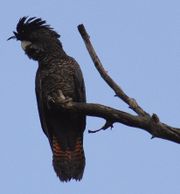
Red-tailed Black Cockatoos measure around 60 centimetres (24 in) in length. The male's plumage is all black with a prominent black crest made up of elongated feathers from the forehead and crown.The bill is dark grey . The tail is also black with two lateral bright red panels. Females are brownish black with yellow-orange stripes in the tail and chest,and yellow spots on the cheeks and wings. The bill is pale and horn-coloured. The underparts are barred with fine yellow over a brownish base. Male birds weigh between 670 and 920 grams (1.5–2 lb), while females weigh slightly less at 615–870 grams (1.25–1.75 lb).[22]
Juvenile Red-tailed Black Cockatoos resemble females until puberty, which occurs around four years of age, but have paler yellow barred underparts.[22] As the birds reach maturity, males gradually replace their yellow tail feathers with red ones; the complete process takes around four years.[37] As with other cockatoos, the Red-tailed Black Cockatoo can be very long-lived in captivity; in 1938, ornithologist Neville Cayley reported one over fifty years old at Taronga Zoo.[38] Another bird residing at London and Rotterdam Zoos was 45 years and 5 months of age when it died in 1979.[39]
Several calls of Red-tailed Black Cockatoos have been recorded. The bird's contact call is a rolling metallic krur-rr or kree, which may carry long distances and is always given while flying;[40] its alarm call is sharp.[40] Displaying males vocalize a sequence of soft growling followed by a repetitive kred-kred-kred-kred.[19]
Distribution and habitat
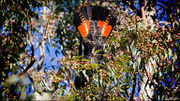
The Red-tailed Black Cockatoo principally occurs across the drier parts of Australia. It is widespread and abundant in a broad band across the northern half of the country, where it has been considered an agricultural pest,[41] with more isolated distribution in the south. It is found in a wide variety of habitats, from shrublands and grasslands through eucalypt, sheoak and Acacia woodlands, to dense tropical rainforests.[5] The bird is dependent on large, old eucalypts for nesting hollows, although the specific gums used vary in different parts of the country.
Cockatoos are not wholly migratory, but they do exhibit regular seasonal movements in different parts of Australia. In the northern parts of the Northern Territory, they largely leave areas of high humidity in the summer wet season.[42] In other parts of the country cockatoo seasonal movements tend to follow food sources, a pattern recorded in Northern Queensland,[43][44] and New South Wales. In southwest Western Australia, both extant subspecies appear to have a north-south pattern; northwards after breeding in the case of subspecies naso,[45] while movements by subspecies samueli in the wheatbelt can be irregular and unrelated to the seasons.[46]
Behaviour
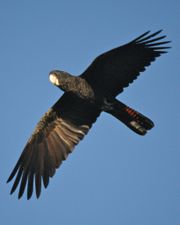
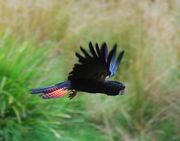
Red-tailed Black Cockatoos are diurnal, raucous and noisy, and are often seen flying high overhead in small flocks, sometimes mixed with other cockatoos. Flocks of up to 500 birds are generally only seen in the north or when the birds are concentrated at some food source. Otherwise, they are generally rather shy of humans.[47] In northern and central Australia, birds may feed on the ground, while the two southern subspecies, graptogyne and naso, are almost exclusively arboreal.[47] They tend to fly rather slowly with intermittent deep flapping wingbeats, markedly different to the shallow wingbeats of the similar Glossy Black Cockatoo. They also often fly at considerable height.[40]
Diet
Although Red-tailed Black Cockatoos feed on a wide variety of native and introduced grains, the mainstay of their diet is eucalyptus seeds. There is a specific relationship between the species and larger-fruited species of gums. These vary across Australia but include the Marri in Southwest Western Australia, Darwin woolybutt E. miniata across the north of the country, E. baxteri in Victoria and the bloodwood species Corymbia polycarpa and C. intermedia in Queensland. Cockatoos bite off branchlets with clusters of seed capsules, then hold them with their feet while chewing and harvesting seeds before littering the ground with debris. Among other seeds and nuts consumed are those of Acacia, Allocasuarina, Banksia, Grevillea and Hakea, as well as berries, fruits and various insects and grubs.[40] Cockatoos have adapted to eating some introduced plants such as the doublegee (Emex australis). There is some evidence of consumption of wild radish (Raphanus raphanistrum), wild turnip (Brassica tournefortii) and melon (Citrullus or Cucumis).[34]
Breeding
The male Red-tailed Black Cockatoo courts by puffing up crest and cheek feathers, and hiding the beak; it then sings and struts, ending in a jump and a flash of red tail feathers toward the female who will most often reply by defensively biting him.[48] Breeding generally takes place from May to September except in the case of the South-eastern subspecies, which nests during summer (December to February). Pairs of the subspecies samueli in the Wheatbelt region of Western Australia may produce two broods,[35] while those of South-eastern subspecies only produce one.[49] Nesting takes place in large vertical tree hollows of tall trees. Isolated trees are generally chosen, so birds can fly to and from them relatively unhindered. The same tree may be used for many years. Hollows can be 1 to 2 metres (3–7 ft) deep and 0.25–0.5 metres (10–20 in) wide, with a base of woodchips. A clutch consists of 1 to 2 white, lustreless eggs, although the second chick is in most cases neglected and perishes in infancy.[50]
 Baby at 1 hour old |
 Baby at 1 day old |
 Baby at 1 week old |
 Baby at 2 weeks old |
 Baby at 3 weeks old |
 Baby at 4 weeks old |
Relationship with humans
Red-tailed Black Cockatoos have been implicated as agricultural pests of peanut and other crops at Lakeland Downs in Far North Queensland. Here the cockatoos, in flocks of up to several hundred birds, have learned to sever the peanut plants above ground level before pulling the peanuts out of the ground by their stems and shelling them. They also damage electrical cables on pivot irrigators.[51][52]
Conservation status
_on_Casuarina_tree.jpg)
The Red-tailed Black Cockatoo is protected under the Australian Environment Protection and Biodiversity Conservation Amendment (Wildlife Protection) Act 2001.[53] These birds are listed internationally under Appendix II of CITES, which allows international trade in live wild-caught and captive-bred specimens, if such exports are not detrimental to wild populations.[54] However, the current Australian restrictions on commercial exports from Australia are not imposed by CITES.[53] C. b. graptogyne is also specifically listed as endangered on the Australian Environment Protection and Biodiversity Conservation Act 1999.
Status of the Red-tailed Black-cockatoo as a species, and as a subspecies, also varies from state to state within Australia. For example:
- The south-eastern Red-tailed Black-cockatoo subspecies C. b. graptogyne is listed as endangered on Schedule 7 of the National Parks and Wildlife Act (1972) of South Australia.[55]
- C. b. graptogyne is also listed as threatened on the Victorian Flora and Fauna Guarantee Act (1988).[56] Under this Act, an Action Statement for the recovery and future management of this species has been prepared.[57] However, it should also be noted that the Red-tailed Black-cockatoo is listed under this Act under its previous Latin name, Calyptorhynchus magnificus. On the 2007 advisory list of threatened vertebrate fauna in Victoria, this subspecies is listed as endangered.[58]
- The Red-tailed Black-cockatoo is listed as vulnerable on the NSW Threatened Species Conservation Act (1995)[59]
Illegal smuggling
Like many Australian cockatoos and parrots, the Red-tailed Black Cockatoo is threatened by the thriving illegal trade in bird smuggling.[60] High demand and high transit mortality mean that many more birds are taken from the wild than actually sold.[61] In 1997, the Northern Territory Government's Department of Natural Resources, Environment and The Arts (NRETA) proposed a management plan of C. b. macrorhynchus to stem the illegal trade in eggs and nestlings. This subspecies, which is relatively abundant in the territory's northern part, was thought plentiful enough to sustain limited harvesting of young for commercial purposes. This involved the protection of selected 'harvest zones' and the capping of harvest at 600 eggs or hatchlings per year; all captive birds were to be marked with microchips. Separate permits would be issued for collection and export, as well as keeping one as a pet.[62]
Proposed NRETA plan
The Northern Territory government's plan for a restricted harvest was supported by a group of biologists who argued that a 'do-nothing approach' had failed to address illegal trafficking and that limited public funds were available for species or habitat conservation. They felt that a catastrophic collapse in the Northern Territory population was highly unlikely, and that the cockatoo would benefit from increased awareness and a greater understanding of its biology by local landowners. There would also be a valuable contribution to the science of sustainable utilisation of wild resources.[63]
Other experts raised serious concerns with the management plan; the famed psittacine biologist Joseph Forshaw opposed it on several grounds. He expressed concerns that, given the birds' short lifespan, recruitment problems may be masked for many years, by which time recovery of the cockatoo population may be impossible. He also feared that increasing supply would lower prices and hence lower profitability for those involved. Other groups such as the Avicultural Federation of Australia (AFA) raised concerns that populations may be aging due to lack of breeding sites, so they may be especially vulnerable to loss of juveniles which, again, may not be apparent for many years. They also feared that since adults mate for life, a bird whose partner was taken may not mate again.[61] To date the plan has not been implemented; the Australian Senate inquiry into the Commercial Utilisation of Australian Native Wildlife concluded in early 1998 that routine capture and commercial use of adult wild birds should be prohibited.[61]
Aviculture

In the late 1990s, Red-tailed Black Cockatoos fetched prices of $1750 in Australia and $8900 (~US$6000) overseas.[3] Hand-raised birds can be bought for anywhere between $15,000 to $40,000 in the United States, where they are seldom seen in aviculture.[64] Hand-reared birds are able to learn a few words and can be quite affectionate, although males may become imprinted and unlikely to breed. The Red-tailed Black Cockatoo is the most commonly seen of the Black Cockatoos in captivity,[2] and can be hardy and long lived if given plenty of space. Until now, most birds in captivity have been of subspecies C. b. banksii and C. b. samueli. Birds were often previously bred without much attention to subspecies of origin. However, with an increase in interest in conservation, more aviculturists are concerned about maintaining the integrity of the separate subspecies in cultivation, and so avoid crossbreeding.[2]
The birds breed easily in captivity[65] and can lay eggs every 3 weeks between February and November. Once the female has one egg in her nest, she will not lay another. An egg takes about 30 days to hatch.[66] The eyes of the young open around 3 weeks and the yellow down will show black pin feathers at about 6 weeks. The best time for hand raising is at about 10 weeks when their black feathers are in place but the tail feathers are still short. Young birds fledge after about 4 months and both sexes have the colouring of their mother. Mature male birds will become aggressive to young male birds at puberty (4 years); they must be separated if caged.[65]
Cultural depictions
A Red-tailed Black Cockatoo, named Karak, was the official mascot of the 2006 Commonwealth Games held in Melbourne. Promotion coincided with an implementation of initiatives to ensure the survival of the South-eastern subspecies graptogyne, as well as increased environmental awareness at the games.[67] A traditional story from western Arnhem Land tells of Black Cockatoo and her husband Crow, who are Bird-people, sprouting black feathers after becoming afflicted with a sickness from across the sea to the north. In fear of being buried underground, they transform into birds and fly high in the sky.[68] In the folklore of the Tiwi people, the Red-tailed Black Cockatoo is said to accompany the dead to heaven.[69]
Notes
- ↑ BirdLife International (2004). Calyptorhynchus banksii. 2006. IUCN Red List of Threatened Species. IUCN 2006. www.iucnredlist.org. Retrieved on 11 May 2006. Database entry includes justification for why this species is of least concern
- ↑ 2.0 2.1 2.2 Forshaw, p. 103
- ↑ 3.0 3.1 Rural Industries Research and Development Corporation (1997). Sustainable Economic of Native Australian Birds and Reptiles – Can controlled trade improve conservation of species?. Barton: The Corporation. p. 3. ISBN 0-642-24638-6.Online summary
- ↑ Latham, John (1790). Index ornithologicus, sive Systema Ornithologiae; complectens avium divisionem in classes, ordines, genera, species, ipsarumque varietates: adjectis synonymis, locis, descriptionibus, &c. :Vol. 1 & 2 xviii 920. London: Leigh & Sotheby. p. 107. OCLC 9637593.
- ↑ 5.0 5.1 Forshaw, p. 94
- ↑ Rowley, Ian (1997). (Cacatuidae summary) "Cacatuidae". In del Hoyo J, Elliott A, Sargatal J. Handbook of the Birds of the World - Volume 4: Sandgrouse to Cuckoos. Lynx Edicions. ISBN 84-87334-22-9. http://www.hbw.com/lynx/en/handbook-birds-world/HBW0004-handbook-birds-world-volume-4.html?fragments=true&fragmentsId=1 (Cacatuidae summary).
- ↑ 7.0 7.1 Lendon, p. 64
- ↑ Schodde R, Bock W (1994). "Case 2856. Psittacus banksii Latham, 1790 and P. lathami Temminck, 1807 (currently Calyptorhynchus banksii and C. lathami; Aves, Psittaciformes): proposed conservation of the specific names". Bulletin of Zoological Nomenclature 51 (3): 253–255.
- ↑ Forshaw, p. 55
- ↑ Liddell, Henry George; Robert Scott (1980). Greek-English Lexicon, Abridged Edition. Oxford: Oxford University Press. ISBN 0-19-910207-4.
- ↑ (French)Desmarest, Anselme Gaëtan (1826). "Perroquet". Dictionnaire des Sciences Naturelles dans lequel on traite méthodiquement des différens êtres de la nature, considérés soit en eux-mêmes, d'après l'état actuel de nos connoissances, soit relativement à l'utilité qu'en peuvent retirer la médecine, l'agriculture, le commerce et les arts. Suivi d'une biographie des plus célèbres naturalistes. Par plusieurs Professeurs du Jardin du Roi, et des principales Écoles de Paris. Strasbourg: F.G. Levrault. pp. 21,117. OCLC 4345179.
- ↑ Jennings, J (1827). Ornithologia; or The Birds: a poem, in two parts; with an introduction to their natural history; and copious notes.. London: Poole & Edwards. p. 399.
- ↑ (Latin) Linnaeus, C (1758). Systema naturae per regna tria naturae, secundum classes, ordines, genera, species, cum characteribus, differentiis, synonymis, locis. Tomus I. Editio decima, reformata.. Holmiae. (Laurentii Salvii).. p. 824. http://dz1.gdz-cms.de/index.php?id=img&no_cache=1&IDDOC=265100.
- ↑ 14.0 14.1 14.2 Forshaw, p. 89
- ↑ Hamilton P (1997). "red-tailed black cockatoo, Calyptorhynchus magnificus". Australian Institute of Aboriginal and Torres Strait Islander Studies. http://www.geocities.com/Athens/Delphi/2970/calyptor.htm. Retrieved 2007-06-08.
- ↑ Goodfellow, Denise Lawungkurr (2005). Birds of Australia's Top End. Parap, Northern Territory: Scrubfowl Press. ISBN 0957884907.
- ↑ Cliff Goddard (1992). Pitjantjatjara/Yankunytjatjara To English Dictionary (2nd ed.). Alice Springs: Institute for Aboriginal Development. p. 21. ISBN 0-949659-64-9.
- ↑ Abbott, Ian (2001). "Karrak-watch: The Forest red-tailed black cockatoo". NartureBase. Western Australia Dept. of Environment and Conservation. http://www.naturebase.net/content/view/2384/482/. Retrieved 2007-06-12.
- ↑ 19.0 19.1 Courtney, J (1996). "The juvenile food-begging calls, food-swallowing vocalisation and begging postures in Australian Cockatoos". Australian Bird Watcher 16: 236–49.
- ↑ Brown DM, Toft CA (1999). "Molecular systematics and biogeography of the cockatoos (Psittaciformes: Cacatuidae)" (PDF). Auk 116 (1): 141–157. http://trc.ucdavis.edu/catoft/reprints/Brown_Toft_1999.pdf. Retrieved 2007-08-16.
- ↑ 21.0 21.1 21.2 Higgins, Peter Jeffrey (1999). Handbook of Australian, New Zealand and Antarctic Birds, Volume 4: Parrots to Dollarbird. Melbourne: Oxford University Press. ISBN 0-19-553071-3.
- ↑ 22.0 22.1 22.2 Forshaw, p. 90
- ↑ Garnett, p.99
- ↑ Hill R, Burnard T. (2001) A Draft Habitat Management Plan for the South-eastern Red-tailed Black-Cockatoo. Unpublished report to the Red-tailed Black-Cockatoo Recovery Team.
- ↑ Ford, J. (1980). "Morphological and ecological divergence and convergence in isolated populations of the Red-tailed Black-Cockatoo". Emu 80 (3): 103–120. doi:10.1071/MU9800103. http://www.publish.csiro.au/paper/MU9800103.htm.
- ↑ Schodde, R. (1988). "New subspecies of Australian birds". Canberra Bird Notes 13 (4): 119–122.
- ↑ Joseph, L. (1982). "The Red-tailed Black-Cockatoo in south-eastern Australia". Emu 82 (1): 42–45. doi:10.1071/MU9820042 (inactive 2010-03-18). http://www.publish.csiro.au/nid/96/paper/MU9820042.htm.
- ↑ Joseph, L.; W.B. Emison & W.M. Bren (1991). "Critical assessment of the conservation status of the Red-tailed Black-Cockatoo in south-eastern Australia with special reference to nesting requirements". Emu 91 (1): 46–50. doi:10.1071/MU9910046. http://www.publish.csiro.au/nid/96/paper/MU9910046.htm.
- ↑ "National Recovery Plan for the South-Eastern Red-Tailed Black-Cockatoo (Calyptorhynchus banksii graptogyne)" (PDF). Australia Department of the Environment and Heritage. 2005. http://www.environment.gov.au/biodiversity/threatened/publications/recovery/c-banksii/index.html. Retrieved 2007-08-12.
- ↑ "Landholders rewarded for helping save red tailed black cockatoo". ABC Southwest Victoria. Australian Broadcasting Corporation. April 4, 2007. http://abc.net.au/news/items/200704/1889333.htm?southwestvic. Retrieved 2007-08-13.
- ↑ Schodde, Richard (February 2000). "The Mathews collection and the Birds of Australia". NLA News. National Library of Australia. http://www.nla.gov.au/pub/nlanews/2000/february00/mathews_birds.html. Retrieved 2007-08-15.
- ↑ Garnett, Stephen T.; Gabriel M. Crowley. "The Action Plan for Australian Birds 2000". Australia Department of the Environment and Heritage. http://www.environment.gov.au/biodiversity/threatened/publications/action/birds2000/ts-list.html. Retrieved 2007-08-12.
- ↑ Garnett, p.100
- ↑ 34.0 34.1 Saunders, D.A.; I. Rowley & G.T. Smith (1985). "The effects of clearing for agriculture on the distribution of cockatoos in the southwest of western Australia". In Keast A, Recher HF, Ford H, Saunders DA. (eds). Birds of Eucalypt Forests and Woodlands: Ecology, Conservation, Management. Chipping Norton: Surrey Beatty. pp. 309–21. ISBN 0-949324-06-X.
- ↑ 35.0 35.1 Saunders, D.A. (1977). "Red-tailed Black-Cockatoo breeding twice a year in the south-west of Western Australia". Emu 77 (3): 107–110. doi:10.1071/MU9770107 (inactive 2010-03-18). http://www.publish.csiro.au/nid/96/paper/MU9770107.htm.
- ↑ Forshaw, p. 91-2
- ↑ Lendon, p. 66
- ↑ Lendon, p. 68
- ↑ Brouwer K, Jones M, King C, Schifter H (2000). "Longevity records for Psittaciformes in captivity". International Zoo Yearbook 37: 299–316. doi:10.1111/j.1748-1090.2000.tb00735.x.
- ↑ 40.0 40.1 40.2 40.3 Forshaw, p. 99-100
- ↑ Lim, T.K.; L. Bowman and S. Tidemann (1993). "A report on the survey of winged vertebrate pest damage on crops in the Northern Territory". Technical bulletin (Northern Territory. Dept. of Primary Industry and Fisheries) (209).
- ↑ Storr GM (1977). Birds of the Northern Territory. Special publications of the Western Australia Museum; 7. Perth: Western Australia Museum. ISBN 0-7244-6281-3.
- ↑ Bravery JA (1970). "The birds of the Atherton Shire, Queensland". Emu 70: 49–63.
- ↑ Gill, HB (1970). "Birds of Innisfail and hinterland". Emu 70: 105–116.
- ↑ Ford JR (1965). "New Information on the distribution of birds of south-western Australia". The Western Australian Naturalist 10 (1): 7–12.
- ↑ Sedgwick, Eric H. (1949). "Bird movements in the wheatbelt of Western Australia". The Western Australian Naturalist 2 (2): 25–33.
- ↑ 47.0 47.1 Forshaw, p. 97-8
- ↑ Forshaw, p. 100
- ↑ Emison WB, White CM, Caldow WD (1995). "Presumptive Renesting of Red-tailed Black-Cockatoos in South-eastern Australia" (PDF). Emu 95: 141–144. http://www.publish.csiro.au/?act=view_file&file_id=MU9950141.pdf. Retrieved 2007-08-13.
- ↑ Beruldsen, Gordon (2003). Australian Birds: Their Nests and Eggs. Kenmore Hills: G. Beruldsen. p. 240. ISBN 0-646-42798-9.
- ↑ Ahmet, Mike. (1998). The damage caused by Red-tailed Black-Cockatoos (Calyptorhynchus banksii) on peanut and other crops within the farming district of Lakeland Downs, Cape York Peninsula. Report to Queensland Department of Environment.[1]
- ↑ Garnett, Stephen. (1998). Red-tailed Black-Cockatoo damage and damage mitigation at Lakeland Downs, Cape York Peninsula. Eclectus 5: 26-34.
- ↑ 53.0 53.1 "Environment Protection and Biodiversity Conservation Amendment (Wildlife Protection) Act 2001". Commonwealth of Australia Law. Australian Government:Attorney-General's Department. 11 July 2001. http://www.comlaw.gov.au/ComLaw/Legislation/Act1.nsf/0/6CF38E3C269AC16FCA256F72000CF0B1?OpenDocument. Retrieved 2007-09-05.
- ↑ Inskipp T, Gillett HJ (2003) (PDF). Checklist of CITES Species. Convention on International Trade in Endangered Species of Wild Fauna and Flora. pp. 84. http://www.cites.org/common/resources/2003_CITES_CheckList.pdf. Retrieved 2007-08-24.
- ↑ NATIONAL PARKS AND WILDLIFE ACT 1972 - SCHEDULE 7
- ↑ Department of Sustainability and Environment, Victoria
- ↑ Department of Sustainability and Environment, Victoria
- ↑ Victorian Department of Sustainability and Environment (2007). Advisory List of Threatened Vertebrate Fauna in Victoria - 2007. East Melbourne, Victoria: Department of Sustainability and Environment. p. 15. ISBN 978-1-74208-039-0.
- ↑ DEC | NSW threatened species - Red-tailed Black-Cockatoo
- ↑ Anon. (1995). "More "Renegades" Sentenced". Traffic USA 14 (2): 6–7.
- ↑ 61.0 61.1 61.2 Senate Rural and Regional Affairs and Transport Committee (2003). "Commercial Utilisation of Australian Native Wildlife - Chapter 13: Aviculture". Parliament of Australia. http://www.aph.gov.au/Senate/committee/rrat_ctte/completed_inquiries/1996-99/wild/report/c13.htm. Retrieved 2007-06-17.
- ↑ Trial Management Program for the Red-tailed Black Cockatoo (Calyptorhynchus banksii) in the Northern Territory of Australia. Parks and Wildlife Commission of the Northern Territory. February 1997.
- ↑ Vardon, M; Noske R, Moyle B (1997). "Harvesting black cockatoos in the Northern Territory: catastrophe or conservation?". Australian Biologist 10 (1): 84–93.
- ↑ Baker, Joe (2007). "Rare, unusual, difficult to find:Black Palm Red Tail and Gang-Gang Cockatoos, Blue Napes, Hawk Heads". Birds of Paradise Aviaries. http://www.bopahi.com/rare.htm#OBC. Retrieved 2007-08-26.
- ↑ 65.0 65.1 Forshaw, p. 104
- ↑ Forshaw, p. 102
- ↑ Dowling, Matt; Jonathan Wright (28 March 2006). "The Karak". Australian Broadcasting Corporation. http://www.abc.net.au/goulburnmurray/stories/s1609144.htm. Retrieved 2007-08-12.
- ↑ Berndt, Catherine H.; Yunupingu, Djoki (1979). Land of the Rainbow Snake: Aboriginal Children's Stories and Songs from Western Arnhem Land. Sydney: Collins. ISBN 0-00-184384-2.
- ↑ Goodfellow, Denise Lawungkurr. pers. comm.
References
- Forshaw, Joseph M.; William T. Cooper (2002). Australian Parrots (3rd ed.). Robina: Alexander Editions. ISBN 0-9581212-0-6.
- Flegg, Jim (2002). Birds of Australia: Photographic Field Guide. Sydney: Reed New Holland. ISBN 1-876334-78-9.
- Lendon, Alan H. (1973). Australian Parrots in Field and Aviary. Angus & Robertson. ISBN 0-207-12424-8.
- Garnett, S. (1993) Threatened and Extinct Birds Of Australia. RAOU. National Library, Canberra. ISSN 0812-8014
External links
- World Parrot Trust Parrot Encyclopedia - Species Profiles
- Website of Conservation Program of South-eastern Red-tailed Black Cockatoo (Calyptorhynchus banksii graptogyne)
|
||||||||||||||||||||||||||||||||||||||||||